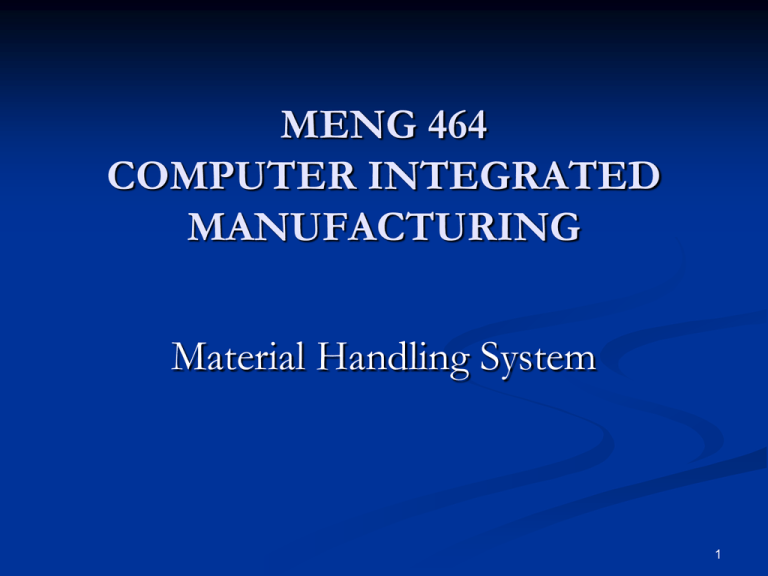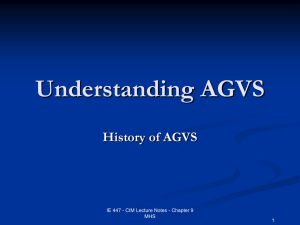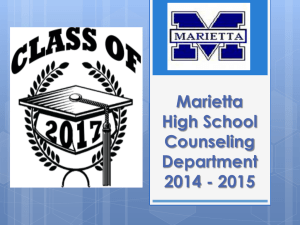Material Handling Systems - Department of Mechanical Engineering
advertisement

MENG 464 COMPUTER INTEGRATED MANUFACTURING Material Handling System 1 Material Handling System Material Handling is the movement, storage, control and protection of materials, goods and products throughout the process of manufacturing, distribution, consumption and disposal. 2 Material Handling System The Material Handling System (MHS) is a fundamental part of a Flexible Manufacturing system since it interconnects the different processes supplying and taking out raw material, work-pieces, sub-products, parts and final products. 3 Material Handling System Components: Robots Conveyors Automated Guided Vehicles(AGVs) Automated Storage/Retrieve System 4 Robots in Manufacturing Industrial robot is a Programmable Multi-functional Designed to move materials, parts, tools or special devices Through programmed motions To perform many different tasks 5 Robots in Manufacturing First industrial robot was developed in the 1950s Further advancements enable to utilize robots in Variety of types Style Size Their functionalities may include but not restricted to Welding Drilling Painting Military applications Assembly Explosive material removal Pick-and-place Material handling 6 Robots in Manufacturing A typical robot consists of many different part connected to each other Most robots resembles a human arm Its motions are controlled by a computer program Depends on the type of robot, movement capabilities of them are measured by the term degrees of freedom 7 Robots in Manufacturing Robots with different degrees of freedoms 2-3 dof Robots used in surgery 8 Robots in Manufacturing How do robots work: there are 3 power sources Hydraulic drive Joints are actuated by hydraulic drivers The major disadvantages are: Floor is used by the installation of hydraulic system Leaks may seen often and cause messy floor Advantages Due to the speed and power, they are used in large industrial robots Also desired to use in the environments where electric-driven robots might cause fire etc. Electric Drive Comparison to Hydraulic systems, less power and slower speed Most common robot types in the industry There are two distinct group: Stepper motors and Direct current (DC) servo-motor driven Pneumatic Drive Usually installed to small robots Tends to have less degrees of freedom Operations are simple and less cycle times Less expensive, Since most of the robot parts are commercially available, small institution can build their own robots 9 Robots in Manufacturing How do we know the location of robot arms? Sensors are used to monitor the motion of robots Motion of robots is sustained by the power based on the given input (computer algorithm) Once the order is given, it is important to know the location of robot’s arm/parts Its movements should be controlled during the entire motion Robot should also be capable of sensing their environments Sensors provides feedback to the controller and give flexibility to robots IE 447 - CIM Lecture Notes - Chapter 9 MHS 10 Robots in Manufacturing Type of sensors being used in robotics 1. Position Sensors Monitors the location of joints Coordinate information is feedback to controller This communication gives the system the capability of location the end-effectors, which is the part usually performs the tasks. 2. Range sensors Measures the distance between a point in the robot and interest point that surrounds the robots The task is usually performed by television cameras or sonar transmitter and receivers If the sonar or camera misses a point, undesired coincidences may occur 3. Velocity sensors Estimates the speed using a moving manipulator Due the the effects caused by, mechanical force, gravity, weight of load etc, desired speed and required force to reach the speed should be computed continuously 4. Proximity sensors Sense and indication of presence of another object within specified distances Prevents accidents and locate the existence of work-piece 11 Robots in Manufacturing Robot movements: Robots are feasible when they are fast but also the stability is high The trade-off between speed and stability is sustained by a powerful control system Robotics and Control are two joint disciplines IE 447 - CIM Lecture Notes - Chapter 9 MHS 12 Robots in Manufacturing Robotic movements and joints 1. 2. 3. 1. 2. 3. 4. Robots required to perform Rotational movements Radial movements Vertical movements Type of joints Rotational joints Twisting joints Revolving joints Linear joints IE 447 - CIM Lecture Notes - Chapter 9 MHS 13 Robots in Manufacturing Analysis of robot motions: Forward and Backward Kinematics concepts Forward Kinematics: Transformation of coordinate of the end-effectors point from the joint space to the world space Position of end-effectors is computed based on the joints locations Backward Kinematics: Transformation of coordinates from world space to joint space In this concept the position of end-effectors is known in world coordinate system Required motion is computed based on this information IE 447 - CIM Lecture Notes - Chapter 9 MHS 14 Robot Configurations (x1, y1) L2 (x2, y2) L3 L1 (x, y) (x, y) (x, y) LL Robot: Base is static, arms are linear joints RRR Robot: Base is static, arms are rotational joints IE 447 - CIM Lecture Notes - Chapter 9 MHS TL Robot: Base is rotational and the arm is linear joint 15 Robots in Manufacturing Essentials of robot programming Requires The path robot should follow The points it should reach Details about how to interpret the sensor data How and when the end-effectors should be activated How to move parts between given locations IE 447 - CIM Lecture Notes - Chapter 9 MHS 16 Robots in Manufacturing Essentials of robot programming Programming techniques Teach-by showing: Textual language programming Robot can repeat the motion already been done by the programmer A computer programming is written using logical statements Some of the languages are: Wave, VAL, AML, RAIL, MCL, TL-10, IRL, PLAW, SINGLA and ACL IE 447 - CIM Lecture Notes - Chapter 9 MHS 17 Robots of IE CIM LAB IE 447 - CIM Lecture Notes - Chapter 9 MHS 18 Robots of IE CIM LAB A four-axis, table-top mounted SCARA robot, the SCORA-ER 14 is designed for work in industrial training facilities. This rugged and reliable robot performs lightpayload assembly, handling and packaging applications with impressive speed and accuracy. SCORA ER14 • Handling and packaging operations with palletizing and storage devices • Assembly operations with automatic screw driving and gluing devices • Quality control operations with machine vision and high-precision measurement devices IE 447 - CIM Lecture Notes - Chapter 9 MHS 19 Robots of IE CIM LAB The SCORBOT-ER 9 is a five-axis vertically articulated robot designed for work in industrial training facilities. With a multi-tasking controller that provides real-time control and synchronization of up to 12 axes, 16 inputs and 16 outputs, the SCORBOT-ER 9 supports both stand-alone applications as well as sophisticated automated work cells. IE 447 - CIM Lecture Notes - Chapter 9 MHS SCORBOT ER9 20 Steps in Robot Programming Programming of an Industrial Task 1. Teach Pendant Operation move the robot arm in AUTO MODE Joints Cartesian Tool coordinates Control robot grippers and the speed of motion Record positions to the robot controller’s memory Move robot arm to recorded positions 1 AXIS 1 X CLR GROUP SELECT RUN CONTROL ON/OFF OPEN CLOSE IE 447 - CIM Lecture Notes - Chapter 9 MHS 4 AXIS 4 7 2 AXIS 2 Y 5 AXIS 5 8 3 AXIS 3 Z 6 AXIS 6 9 0 SELECT AXIS AXIS 7 AXIS 8 AXIS 9 SINGLE STEP SPLINE INSERT MOVE C DELETE MOVE SPEED (%) ENTER MOVE L SPEED L(%) EXECUTE ABORT RECORD POSITION 21 Steps in Robot Programming Programming of an Industrial Task 2. Writing robot programs Use ACL (Automatic Control Language) to edit robot programs. Commonly used robot program statements. MOVE: MOVED: OPEN: CLOSE: SPEED: IE 447 - CIM Lecture Notes - Chapter 9 MHS 22 Steps in Robot Programming Programming of an Industrial Task 3. Executing Robot Programs Use ATS DIRECT Mode; Statements to execute; RUN prgname : To execute the program prgname ABORT: To abort the current running robot program. IE 447 - CIM Lecture Notes - Chapter 9 MHS 23 Conveyors In CIM Conveyors type: Belt Conveyors Roller Conveyors Crane Conveyors Screw Conveyors … IE 447 - CIM Lecture Notes - Chapter 9 MHS 24 Conveyors In CIM The package conveyor business has been in existence for almost one hundred years. Material handling engineering, in an oversimplified, basically, consists of determining "how a product should be moved from one place to another, within the shortest allowable period of time, for the least cost and with the least amount of manual effort". IE 447 - CIM Lecture Notes - Chapter 9 MHS 25 Conveyors In CIM Classification of conveyors: Active; Energy is supplied to the component for the movement of the materials, upward movements. Passive; No energy is supplied to the component and gravity force is utilized for the movement of the materials, mostly downward movements. IE 447 - CIM Lecture Notes - Chapter 9 MHS 26 Conveyors In CIM Classification of conveyors Continuous movement; Applicable for the movement of continuous material such as liquids, sand, soil and cereals. District movement; Applicable for the movement of district material such as boxes, parts, cans and… IE 447 - CIM Lecture Notes - Chapter 9 MHS 27 Material Handling Systems Automatic Guided Vehicle Systems AGVS IE 447 - CIM Lecture Notes - Chapter 9 MHS 28 Understanding AGVS History of AGVS IE 447 - CIM Lecture Notes - Chapter 9 MHS 29 History of AGVS 1953 First AGV The first AGV system was built and introduced in 1953( A modified towing tractor that was used to pull a trailer and follow an overhead wire in a grocery warehouse) IE 447 - CIM Lecture Notes - Chapter 9 MHS 30 History of AGVS 1973 Volvo Assembly Plant In 1973, Volvo in Kalmar, Sweden set out to develop non-synchronous assembly equipment as an alternative to the conventional conveyor assembly line. The result was 280 computercontrolled assembly AGVs. IE 447 - CIM Lecture Notes - Chapter 9 MHS 31 History of AGVS 1970s First Unit Load Introduction of a unit load vehicle They have the ability to serve several functions; a work platform, a transportation device, and a link in the control and information system They transport material in warehouses, factories, mills, hospitals, and other industrial and commercial settings. IE 447 - CIM Lecture Notes - Chapter 9 MHS 32 History of AGVS Smart Floors and Dumb Vehicles In the 1970’s the principal guidance technology was to induce an electronic frequency through a wire that was buried in the floor. ‘floor controller’ •These first generation navigation schemes were expensive to install. •All floor cuts needed to follow the exact path of the AGV. IE 447 - CIM Lecture Notes - Chapter 9 MHS 33 History of AGVS Dead Reckoning Capability As the vehicles became more intelligent, the path became less sophisticated Dead reckoning is a term that describes the ability of a vehicle to traverse steel expansion joints on the factory floor or to cross a steel grate The biggest advantage was that dead reckoning eliminated the need to make the cut radius turns at intersections. (Installation was greatly simplified). IE 447 - CIM Lecture Notes - Chapter 9 MHS 34 History of AGVS 1980s Non-Wire Guidance The introduction of laser and inertia guidance. Allow for increased system flexibility and accuracy No need for floor alterations or production interruption IE 447 - CIM Lecture Notes - Chapter 9 MHS 35 AGV NAVIGATION The principles which make it possible for an AGV to navigate its way between any two locations are really quite simple. All navigation methods use a path. The vehicle is instructed to Follow a Fixed Path or Take an Open Path. IE 447 - CIM Lecture Notes - Chapter 9 MHS 36 Fixed Path Navigation Following a Path The paths are well marked on the floor The paths are continuous The paths are fixed, but can be changed IE 447 - CIM Lecture Notes - Chapter 9 MHS 37 Fixed Path Navigation: Creating a Path The principle techniques for creating paths are to: Apply a narrow magnetic tape on the surface of the floor Apply a narrow photo sensitive chemical strip on the surface of the floor Apply a narrow photo reflective tape on the surface of the floor Bury a wire just below the surface of the floor IE 447 - CIM Lecture Notes - Chapter 9 MHS 38 Fixed Path Navigation: Buried Wire Path Bury a current-carrying wire just below the surface of the floor IE 447 - CIM Lecture Notes - Chapter 9 MHS 39 Fixed Path Navigation: Steering Correction Coils The vehicle steers itself to FOLLOW the magnetic field surrounding the buried wire. IE 447 - CIM Lecture Notes - Chapter 9 MHS 40 Fixed Path Navigation: Path Selection In this illustration, a vehicle at “A” has two choices on how to get to “B”. A computer either on board the vehicle or at some central location selects a path based on established criteria. Criteria: The shortest distance The path with the least traffic at the present time All of the “PATH FOLLOWING” methods permit routing options that include guide path switching and merging. IE 447 - CIM Lecture Notes - Chapter 9 MHS 41 Open Path Navigation: Taking a Path Unlike “path following navigation,” where the guide paths are fixed, and more or less permanent, vehicles operating in the “Take a Path” category are actually offered more variation if not an infinite number of ways to navigate the open space between two points. IE 447 - CIM Lecture Notes - Chapter 9 MHS 42 Open Path Navigation: Navigation Methods The three most common open space navigation methods are: Laser Guidance Inertial Guidance Cartesian Guidance The choice of navigation method for a particular application is often a simple matter of preference. IE 447 - CIM Lecture Notes - Chapter 9 MHS 43 Navigation Methods - Laser Guidance Reference points are strategically located targets A beacon on top of the vehicle emits a rotating laser beam which is reflected back to the vehicle when it strikes (sees) a target. IE 447 - CIM Lecture Notes - Chapter 9 MHS 44 Navigation Methods - Inertial Guidance An on board gyroscope establishes and maintains a vehicle’s heading. Distance traveled is calculated by an on board encoder which counts wheel rotations. IE 447 - CIM Lecture Notes - Chapter 9 MHS 45 Navigation Methods – Cartesian Guidance Location precision is accomplished by way of a fixed grid pattern that covers the entire floor area. The possible travel paths in a given, unrestricted operating area for a grid based system are infinite and most like that provided by laser guidance IE 447 - CIM Lecture Notes - Chapter 9 MHS 46 AGVS Dispatching Dispatching AGVS is much the same as dispatching taxi cabs. The dispatch function makes sure that all customers get timely services from the vehicle best able to service a request. Remote and local dispatch are most commonly described as offboard and onboard dispatchers respectively. IE 447 - CIM Lecture Notes - Chapter 9 MHS 47 AGVS Communications Communications include message commands such as: where to go, when to start, when to slow down, when to stop. Four types of basic communication media: Radio Communication Infrared Communication Guide Wire Data Communication Inductive Loops Communication IE 447 - CIM Lecture Notes - Chapter 9 MHS 48 AGVS Communications Radio Communication Maximum flexibility in system control Vehicles can be programmed “on the fly” system speed of response to changing load movement demands is improved IE 447 - CIM Lecture Notes - Chapter 9 MHS 49 AGVS Communications Infrared Communication Optical infrared communication is highly reliable but has the disadvantage of not being continuous; it is point to point. Vehicles may be stopped during this data exchange which usually occurs at load stations where the fixed and mobile units are aligned and in close proximity. Or, the vehicle communicates at fixed points along its guide path as the vehicle travels through a given zone. Infrared communication is best suited for small systems with few vehicles and load stations. IE 447 - CIM Lecture Notes - Chapter 9 MHS 50 Remote Dispatching The Dispatcher The remote dispatch function generally resides in a computer (PC), Programmable Controller (PLC), or other microprocessor, known as the Dispatcher. The Dispatcher accepts input from the various system Components (generally transport requests) and directs the AGVS to fulfill the command in the most efficient manner. Remote dispatch can occur with vehicles at single or various dispatch points. IE 447 - CIM Lecture Notes - Chapter 9 MHS 51 AGVS Monitoring Types of monitoring : System monitoring Vehicle monitoring The functions and reporting capabilities of each are important to the safe operation of the AGVs. IE 447 - CIM Lecture Notes - Chapter 9 MHS 52 Material Handling Systems Automatic Storage Retrieve Systems AS/RS IE 447 - CIM Lecture Notes - Chapter 9 MHS 53 IE 447 - CIM Lecture Notes - Chapter 9 MHS 54 IE 447 - CIM Lecture Notes - Chapter 9 MHS 55 IE 447 - CIM Lecture Notes - Chapter 9 MHS 56 IE 447 - CIM Lecture Notes - Chapter 9 MHS 57 IE 447 - CIM Lecture Notes - Chapter 9 MHS 58 Principles of Materials Handling Introduction: Certain fundamental principles for analyzing and designing solutions to materials handling problems have been developed over a period of time based on experience of many materials handling experts. These can be used as general guide by any fresh materials handling practitioner, for analyzing a materials handling problem and arriving at a solution to same. Many of the materials handling problems may be initially treated by these principles before undertaking detailed technical analysis. In certain materials handling problems, these principles may become the only resort to an acceptable solution where the exact analysis is too costly or difficult. MENG 464 - CIM Lecture Notes Chapter 9 MHS 59 PLANNING PRINCIPLE All handling activities should be planned. This is the most basic principle which is in line withthe Materials Handling Equation (see block below).Suggestions for carrying out planning principles are: • Consider the plant layout before equipment / system design. • Plan correct location for materials supply and disposal. Plan for scrap removal. • Assure adequate storage space at the workplace. • Avoid placing materials directly on the floor. Place product on a pallet, skid etc. at the beginning of the process. • Use same container throughout the materials movement, as far as practicable. • Observe principles of motions economy. • Plan productive operations and inspections during material movement, if possible. • Use judicious amount of manual handling. IE 447 - CIM Lecture Notes - Chapter 9 MHS 60 SYSTEMS PRINCIPLE Integrate as many handling activities as possible encompassing full scope of operations like receiving, storage, production, inspection, packaging, warehousing, shipping/transportation. Suggestions: • Consider the entire scope of the handling activities, beyond the scope of immediate concern. • Integrate operations into handling systems like processing, inspection, packaging etc. • Avoid/ minimize intermediate storage. • While designing a materials handling system, the practices/requirements of the suppliers, clients and transporters are to be considered. • Allow necessary flexibility considering future requirements/emergencies. IE 447 - CIM Lecture Notes - Chapter 9 MHS 61 MATERIAL FLOW PRINCIPLE Plan operations sequence and equipment arrangement to optimize material flow. Suggestions: • Eliminate obstacles from material flow. • Plan material movement in a direct path (avoid backtracking, zig-zag movements etc.) • Use product layout whenever possible. • Keep related work areas close together. • Combine operations to reduce material movement. • Minimize movement between floors. • Move bulky / weighty materials the least distance. • Process heavy / bulky materials close to receiving. IE 447 - CIM Lecture Notes - Chapter 9 MHS 62 SIMPLIFICATION PRINCIPLE Reduce, combine or eliminate unnecessary movement and/or equipment. It increases efficiency of materials handling. Suggestions: • Apply principles of motions economy. Avoid unnecessary handling. Eliminate rehandling as much as possible. • Plan direct moves. Reduce or eliminate long, awkward or complicated moves. • Deliver materials at correct location first time. • Use material out of original container. • Avoid use of variety of equipment types, sizes and makes. • Plan adequate material handling equipment capacity. • Do not mechanize unnecessarily. IE 447 - CIM Lecture Notes - Chapter 9 MHS 63 GRAVITY PRINCIPLE Utilize gravity to move material whenever practicable. Suggestions: • Use roller conveyors, slides, chutes between equipment/processes. • Use ramps between varying work or floor levels. • Use sloping floor when materials movement by hand truck is mainly in one direction. • Use spiral chutes to feed machines at different floors. IE 447 - CIM Lecture Notes - Chapter 9 MHS 64 SPACE UTILIZATION PRINCIPLE Make optimum use of building volume. Suggestions: • Space equipment/processes close together. • Eliminate or reduce temporary storage of materials. • Stack materials to use building height. • Use racks to permit higher stacking. • Use stacking containers to permit stacking. • Exercise economic order quantities to reduce inventory. • Clean storage areas and dispose scrap regularly. • Use narrow aisle handling equipment to reduce aisle width. IE 447 - CIM Lecture Notes - Chapter 9 MHS 65 MECHANIZATION/AUTOMA TION PRINCIPLE When appropriate, use mechanized or automatic materials handling equipment. Suggestions: • Consider mechanized system in the following cases: (a) Large quantities or volumes of materials, (b) Repetitive movement, (c) Long moves, (d) Hazardous move/materials, (e) Two man lifting, moving tasks, (f) Excess manual handling, (g) Replacing large number of persons involved in handling, (h) Heavy materials, (i) Scrap removal, (j) Feeding/unloading of high speed automated production machines. • Do not over mechanize. IE 447 - CIM Lecture Notes - Chapter 9 MHS 66 EQUIPMENT SELECTION PRINCIPLE Before selecting materials handling equipment, consider all aspects of materials handling,e.g., materials to be handled, moves to be made, methods to be utilized. PRINCIPLES OF MATERIALS HANDLING 13 Suggestions: • Select versatile equipment. • Select standardized equipment. • Consider unitization of load for handling. • Select capacity judiciously. Provide additional capacity based on future plan. • Compare alternatives based on cost of handling. IE 447 - CIM Lecture Notes - Chapter 9 MHS 67 STANDARDIZATION PRINCIPLE Materials handling methods and equipment should be standardized to the extent possible. Suggestions: • Use standardized containers. • Purchase standard types and sizes of equipment. • Use standard sizes of pallets to fit products, bay sizes, equipment and transport trucks. IE 447 - CIM Lecture Notes - Chapter 9 MHS 68 FLEXIBILITY PRINCIPLE Use methods and equipment, which can perform different tasks and applications. Suggestions: • Buy flexible equipment like Fork Lift Truck, Conveyor etc. • Use variable speed drives. • Make use of attachment & accessories. • Use four ways pallets, skids and containers. • Utilize mobile in favour of fixed equipment (e.g. trucks in favour of fixed conveyors) IE 447 - CIM Lecture Notes - Chapter 9 MHS 69 MOTION PRINCIPLE Stoppage of mobile equipment should be minimum. Suggestions: • Reduce loading/unloading time. • Load/unload while materials handling equipment is in motion, if possible. • Use mechanized loading/unloading equipment. 14 INTRODUCTION TO MATERIALS HANDLING • Use self-loading/unloading equipment like lift truck. • Plan materials movement on both ways movement of materials handling equipment. • Use equipment where carrying device is attached to motive unit like platform-type trucks, trailers etc. • Use pallets, skids etc. to hasten loading/unloading. • Use devices like tipplers, bottom discharge containers etc. IE 447 - CIM Lecture Notes - Chapter 9 MHS 70 IDLE TIME PRINCIPLE Reduce idle or unproductive time of both materials handling equipment and manpower. This principle is similar to motion principle, so far as materials handling equipment are concerned, hence same suggestions are applicable. Additional suggestions for ‘‘manpower’’ are: • Deliver materials at proper rate so that operators are not idle for materials. • Use indirect labour for materials handling. • Install handling equipment to reduce labour. • Combine jobs i.e. one man handles two or more machines or jobs. IE 447 - CIM Lecture Notes - Chapter 9 MHS 71







